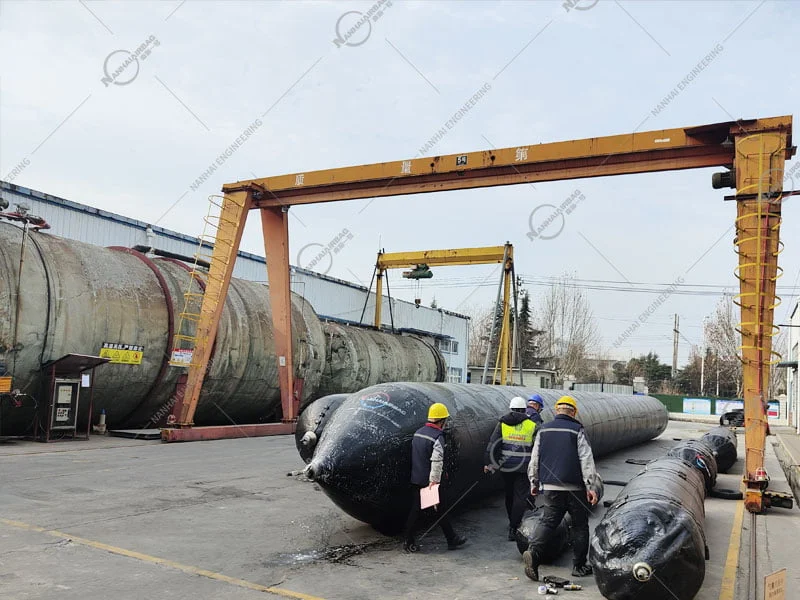Rubber Fender Testing Items
06/27/2025The Science of Cone Fenders: Compression, Deflection & Shear
06/27/2025Things to pay attention to when using ship launching airbags
Why Is This Topic Important?
In recent years, ship launching airbags—also known as marine airbags or ship airbags—have become a preferred method for launching and upgrading vessels due to their cost-effectiveness, flexibility, and low infrastructure demands.
However, improper use can lead to serious accidents, including airbag bursting, misalignment, or vessel instability. For example, a 1000-ton passenger vessel experienced a tilt during launching because the airbag diameter was mismatched. That’s why understanding how to use them properly is not just a technical detail—it’s essential for safety, efficiency, and cost savings.

Featured Snippets
Match the airbag size and specs with the vessel requirements
Make sure the airbag’s diameter is larger than the height of vessel blocks, and select the right number of layers (typically 6–8) for your vessel’s weight.
Calculate airbag quantity and spacing precisely
Use proper formulas and prepare 2–4 spare airbags in case of emergency. Spacing should balance vessel stability and rolling efficiency.
Prepare the slipway surface carefully
Clear away debris, sharp objects, and ensure a clean surface to prevent airbag damage.
Verify airbags per ISO 14409
Check for airtightness, burst pressure (≥3× rated pressure), and elasticity to ensure safety compliance.
Control air pressure and release rhythm
Avoid sudden slips by adjusting pressure gradually and using a double-brake system during launching.
Use proper winch and towing system
All pulling systems must meet calculated force requirements. Test steel wires and mark hazard zones in advance.
Practical Guidelines: Launching & Upgrading with Marine Airbags
1. Ensure Parallel Airbag Alignment during Ship Upgrading
When performing ship upgrading (haul-out) operations, all airbags must be placed parallel to each other and perpendicular to the vessel’s centerline. This alignment minimizes rolling resistance and reduces winch power requirements, especially during the initial pull.
2. Adjust Airbags to Prevent Winch Overload
If the winch is under excessive stress during the haul-out process, it’s a sign the airbags are misaligned or uneven. Immediately pause and readjust to avoid overload or cable breakage.
3. Secure Airbags during Launching
Once the vessel is in place near the slipway’s edge or at the tidal line, secure all airbags with steel wires to prevent them from being pushed away or dislodged during the launching sequence.
4. Deflate Airbags During Ebb Tide
After the tide goes out, carefully deflate the airbags so the ship rests fully on them. If possible, apply vacuum to remove internal air completely. This allows for smoother retraction when the vessel is moved.
However, if there’s a risk the vessel may not float during high tide, retain a few airbags—especially at the stern—with low pressure. These provide just enough buoyancy to support the vessel while enabling smooth airbag ejection during towing.
Advanced Tips for Safe and Efficient Use
Choose the Right Airbag Size
- Diameter: Should be 0.2–0.3m larger than the keel block height
- Layers: Usually 6 to 8 layers; larger vessels may need reinforced models
Calculate Quantity and Spacing
- Use:
N = K¹·Q·g / (C_b·R·L_d) - Follow spacing rule:
L/(N–1) ≥ πD/2 + 0.3m, but keep total ≤6K (K is material factor)
Prepare the Site
- Remove protrusions, barnacles, and welding slag from the hull bottom
- Smooth the launching slope and lay rubber mats if necessary
Launch Safely
- Control towing speed: 9–13 m/min
- Use double braking and live monitor pressure and movement
- Fix position markers based on tidal level
Why Choose NANHAI Ship Launching Airbags?
At NANHAI, we supply high-performance marine airbags certified under ISO 14409/17682 standards. We go beyond just selling—our engineers provide full technical support from selection, testing to on-site guidance. Our airbags are used worldwide in vessel launching, upgrading, salvage, and offshore engineering.
Whether you’re launching a fishing boat or hauling a cargo vessel, NANHAI airbags deliver reliability, durability, and peace of mind.
FAQ
What are marine airbags used for?
Marine airbags are high-strength rubber bladders used to launch, land, or upgrade ships by rolling or supporting them onshore or into water.
How do I prevent airbag damage during launching?
Ensure a clean slipway, match the correct size and layer of airbag, and secure the airbags during vessel movement.
Can airbags be reused?
Yes, quality marine airbags can be reused many times if properly maintained and pressure-checked before each use.
What if the vessel won’t float after tide rises?
Keep some airbags at the stern with slight pressure to provide lift during towing and allow smooth removal of the airbags.
Ready to Launch Safely with NANHAI?
If you’re planning to use ship launching airbags, don’t leave anything to chance. Contact NANHAI today for expert advice, customized design, and reliable products trusted by shipyards worldwide.
